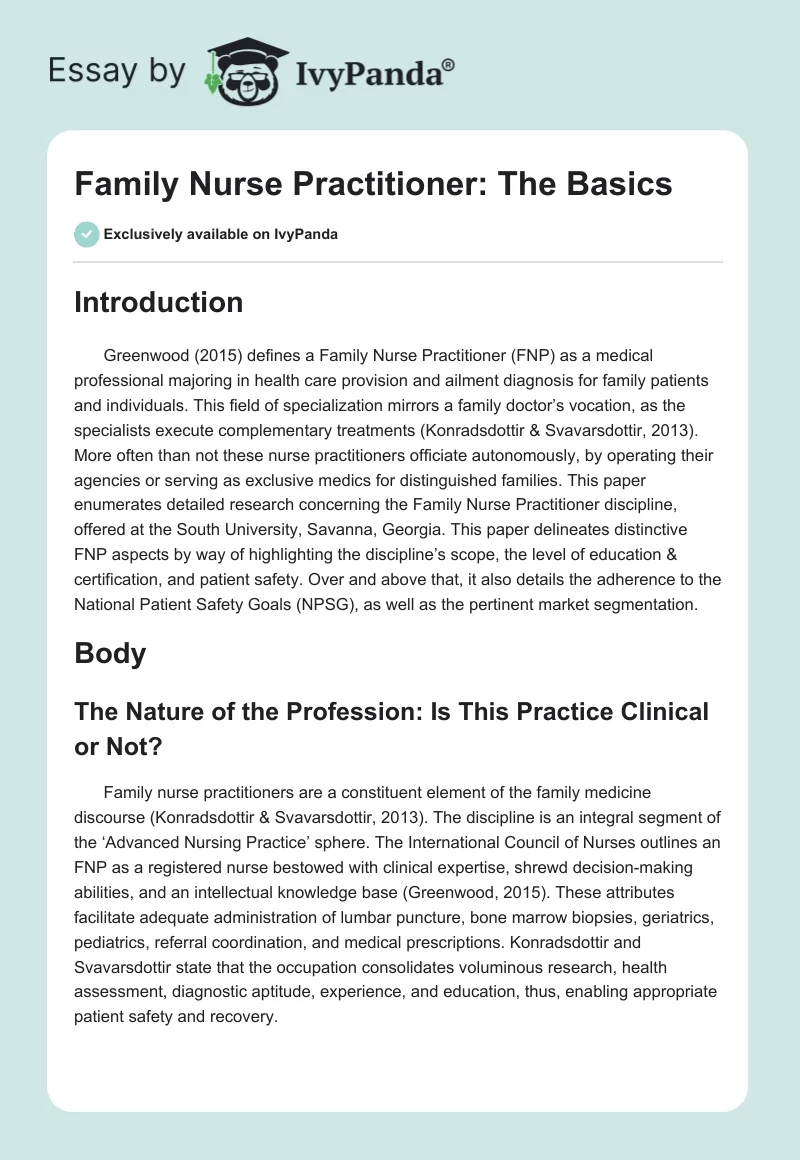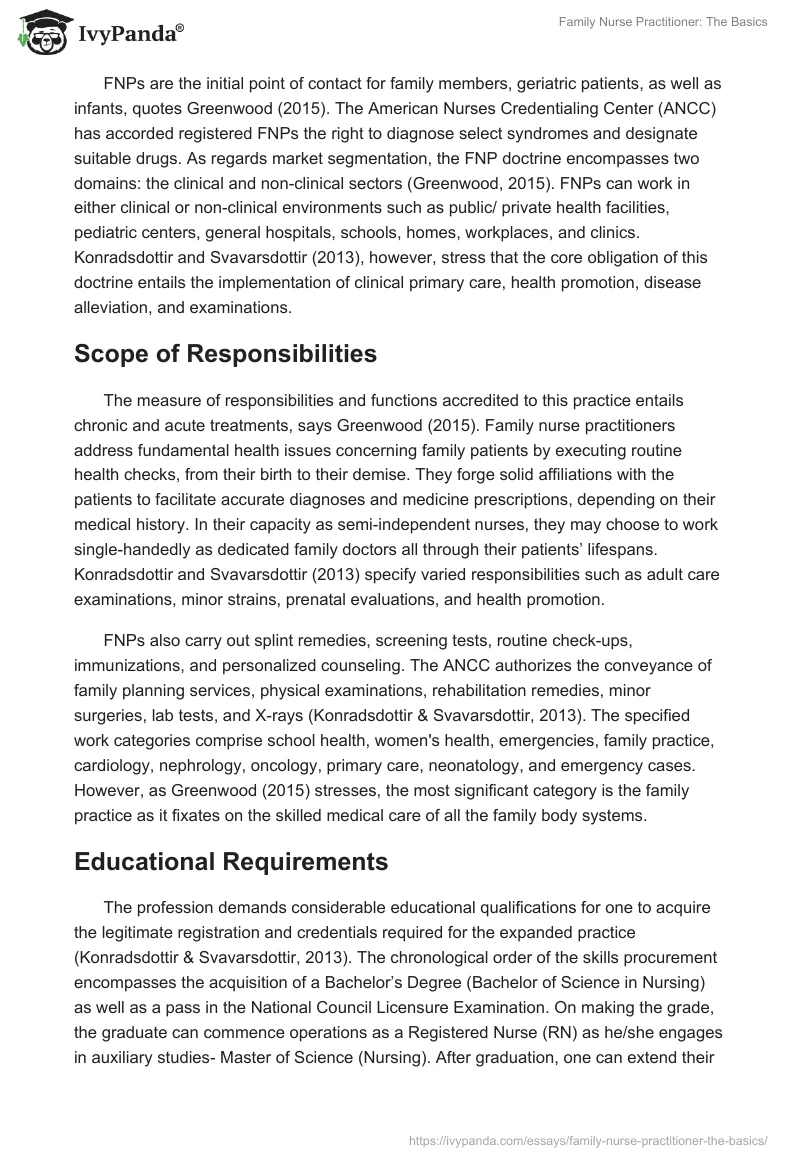Introduction
Greenwood (2015) defines a Family Nurse Practitioner (FNP) as a medical professional majoring in health care provision and ailment diagnosis for family patients and individuals. This field of specialization mirrors a family doctor’s vocation, as the specialists execute complementary treatments (Konradsdottir & Svavarsdottir, 2013). More often than not these nurse practitioners officiate autonomously, by operating their agencies or serving as exclusive medics for distinguished families. This paper enumerates detailed research concerning the Family Nurse Practitioner discipline, offered at the South University, Savanna, Georgia. This paper delineates distinctive FNP aspects by way of highlighting the discipline’s scope, the level of education & certification, and patient safety. Over and above that, it also details the adherence to the National Patient Safety Goals (NPSG), as well as the pertinent market segmentation.
Body
The Nature of the Profession: Is This Practice Clinical or Not?
Family nurse practitioners are a constituent element of the family medicine discourse (Konradsdottir & Svavarsdottir, 2013). The discipline is an integral segment of the ‘Advanced Nursing Practice’ sphere. The International Council of Nurses outlines an FNP as a registered nurse bestowed with clinical expertise, shrewd decision-making abilities, and an intellectual knowledge base (Greenwood, 2015). These attributes facilitate adequate administration of lumbar puncture, bone marrow biopsies, geriatrics, pediatrics, referral coordination, and medical prescriptions. Konradsdottir and Svavarsdottir state that the occupation consolidates voluminous research, health assessment, diagnostic aptitude, experience, and education, thus, enabling appropriate patient safety and recovery.
FNPs are the initial point of contact for family members, geriatric patients, as well as infants, quotes Greenwood (2015). The American Nurses Credentialing Center (ANCC) has accorded registered FNPs the right to diagnose select syndromes and designate suitable drugs. As regards market segmentation, the FNP doctrine encompasses two domains: the clinical and non-clinical sectors (Greenwood, 2015). FNPs can work in either clinical or non-clinical environments such as public/ private health facilities, pediatric centers, general hospitals, schools, homes, workplaces, and clinics. Konradsdottir and Svavarsdottir (2013), however, stress that the core obligation of this doctrine entails the implementation of clinical primary care, health promotion, disease alleviation, and examinations.
Scope of Responsibilities
The measure of responsibilities and functions accredited to this practice entails chronic and acute treatments, says Greenwood (2015). Family nurse practitioners address fundamental health issues concerning family patients by executing routine health checks, from their birth to their demise. They forge solid affiliations with the patients to facilitate accurate diagnoses and medicine prescriptions, depending on their medical history. In their capacity as semi-independent nurses, they may choose to work single-handedly as dedicated family doctors all through their patients’ lifespans. Konradsdottir and Svavarsdottir (2013) specify varied responsibilities such as adult care examinations, minor strains, prenatal evaluations, and health promotion.
FNPs also carry out splint remedies, screening tests, routine check-ups, immunizations, and personalized counseling. The ANCC authorizes the conveyance of family planning services, physical examinations, rehabilitation remedies, minor surgeries, lab tests, and X-rays (Konradsdottir & Svavarsdottir, 2013). The specified work categories comprise school health, women’s health, emergencies, family practice, cardiology, nephrology, oncology, primary care, neonatology, and emergency cases. However, as Greenwood (2015) stresses, the most significant category is the family practice as it fixates on the skilled medical care of all the family body systems.
Educational Requirements
The profession demands considerable educational qualifications for one to acquire the legitimate registration and credentials required for the expanded practice (Konradsdottir & Svavarsdottir, 2013). The chronological order of the skills procurement encompasses the acquisition of a Bachelor’s Degree (Bachelor of Science in Nursing) as well as a pass in the National Council Licensure Examination. On making the grade, the graduate can commence operations as a Registered Nurse (RN) as he/she engages in auxiliary studies- Master of Science (Nursing). After graduation, one can extend their coaching in areas such as intervention concerns, primary wellness programs, chronic illness management, family nursing theory, and leadership preparation. As Erickson asserts, these modules and programs will certainly help the apprentice to seize the ANCC board accreditation- courtesy of the American Academy of Nurse Practitioners (2014).
Compliance with the NPSG: Promotion of Patient Safety
According to Erickson (2014), the National Patient Safety Goals endorse patient safety observance and welfare across all medical realms. As regards the FNP field of practice, the NPSG principles function to diffuse germane complications such as bedsores, medicine application, and resident identification. The following standards constitute the various ways and means employed to ameliorate the setbacks encountered during the enforcement of care treatments (Erickson, 2014).
Resident identification
The patient recognition strategy sanctions the exploitation of astute patient identifiers to deflect chronic diagnosis errors and omissions (Greenwood, 2015). The commendable identifiers include tagging blood samples and clinical testing specimens. Erickson (2014) lists other equally important individual-specific attributes including the person’s name, identification integer, telephone number, facial recognition, and date of birth. These qualifiers help ensure that the nurse practitioners deliver equitable medical procedures, remedies, and drugs to the relevant individuals, hence avoiding confusion.
Medication intake
According to Erickson (2014), supreme care should prevail when passing along instructions, concerning the intake and consumption of medicinal drugs, to the corresponding residents. The practitioner should first retrieve details of the sedatives and prescriptions that a patient is consuming presently before issuing the new narcotics (Konradsdottir & Svavarsdottir, 2013). It is imperative to advise the residents on the effectiveness of notifying the doctor about the drugs they are taking now. This emphasis enables the nurse to amass comprehensive medication information and conduct comparisons/ reconciliations between the old and newly prescribed sedatives. This information also helps abate adverse patient outcomes affiliated with medication inconsistencies, omissions, interactions, and duplications (Erickson, 2014).
Deterrence of relative infections
As Erickson (2014) clarifies, masses of residents obtain new viruses and contaminations while undergoing nursing procedures at medical facilities. Therefore, the Centers for Disease Control and Prevention stipulate rigid standards of hygiene and personal cleanliness, especially for FNPs. The standards underline the absolute observance of the hand-cleaning guidelines and standardized protocols for the purposes of augmenting patient safety and alleviating bloodstream infections.
Pressure ulcers
The NPSG cautions FNPs to evaluate the presence and risk level of pressure ulcers using Norton and Braden Scale, on a regular basis (Konradsdottir & Svavarsdottir, 2013). If present, the nurses should implement injury prevention by revamping the tolerance of the tissue and exterior mechanical forces.
Conclusion
In conclusion, family nurse practitioners expedite vital treatments and consistent care for patients with chronic ailments (Konradsdottir & Svavarsdottir, 2013). The FNP should be in a position of apprehending the overall medical history of relevant patients to help them discern their distinctive ailments and establish effective wellness. Observance of patient safety, resident identification, and hand hygiene protocols help the family nurse practitioners dispense commendable patient support.
References
Erickson, A. (2014). Safety first: The latest updates from the Joint Commission. Pharmacy, 20(8), 2-13.
Greenwood, B. (2015). Family nurse practitioner: Role & responsibilities. Web.
Konradsdottir, E., & Svavarsdottir, K. (2013). The role of advanced nurse practitioners in offering brief therapeutic conversation intervention for families of children and adolescents with diabetes type 1. Nordic Journal of Nursing Research & Clinical Studies, 33(3), 38-49.


